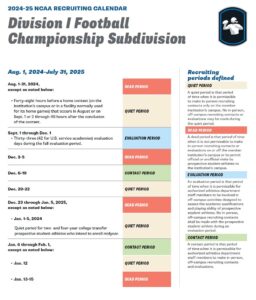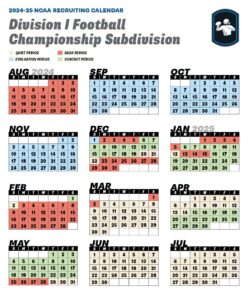In the high-stakes world of college football recruiting, timing is everything. The NCAA’s recruiting calendar serves as a carefully orchestrated symphony, with periods of intense activity balanced by strategic pauses known as “dead periods” or “blackout periods.” These crucial intervals shape the future of college football programs and the destinies of aspiring student-athletes across the nation.
The Philosophy Behind the Calendar
The recruiting calendar represents more than just dates on a page—it embodies the NCAA’s commitment to maintaining competitive balance while protecting the academic and personal lives of student-athletes. By establishing distinct periods throughout the year, the NCAA creates a structured environment where both coaches and prospects can make informed decisions without constant pressure.
Division I Football Bowl Subdivision (FBS): The Premier Stage
The FBS calendar for 2024-2025 reflects the complexity of top-tier college football recruiting. During the designated dead periods, from August’s summer heat through winter’s championship games, all in-person contact grinds to a halt. These periods include:
championship games, all in-person contact grinds to a halt. These periods include:
The late summer evaluation freeze (August 1-31, 2024), allowing high school athletes to focus on their upcoming season without recruiting distractions. The early December pause (December 2-8, 2024) coincides with conference championships and bowl game selections, ensuring coaches focus on their current teams during this crucial time. The holiday period (December 23, 2024 – January 5, 2025) provides a much-needed respite for all parties during the festive season.
Division I Football Championship Subdivision (FCS): A Parallel Path
The FCS calendar mirrors its FBS counterpart in many ways, though with subtle variations that reflect the different competitive landscape of this division. Their dead periods maintain similar timing but often differ in duration, demonstrating the NCAA’s recognition that different levels of competition require different approaches to recruitment.
Division II: A More Flexible Approach
Division II programs operate under a more streamlined calendar, with fewer restrictions reflecting their different competitive and resource environments. Their dead periods are more focused, primarily clustering around key decision-making times for mid-year enrollees and the traditional signing period.
The Impact on Modern Recruiting
These calendar restrictions have profound effects on how programs build their teams. Traditional summer recruiting events must now adapt to new timelines. Major programs have had to reimagine their showcase events, with institutions like Penn State, Michigan, and Oregon finding creative ways to work within the calendar’s constraints.
Beyond the Dead Periods
The recruiting calendar operates like a traffic light system, with different periods signaling when various types of contact are permitted:
Contact periods serve as the “green light,” allowing coaches to meet prospects face-to-face off-campus. These periods often see coaches traveling extensively to visit high schools and homes across the country.
Evaluation periods function as a “yellow light,” where coaches can watch prospects compete but must maintain their distance. This time is crucial for assessing athletic ability in authentic game situations.
Quiet periods act as a “slow” signal, restricting in-person contact to campus visits only. These periods often allow programs to showcase their facilities and culture to interested prospects.
Looking Ahead: Navigation and Adaptation
Success in college football recruiting increasingly depends on understanding and adapting to these calendar restrictions. Coaches must now leverage technology and careful planning to maintain relationships during dead periods, while prospects need to strategically schedule their visits and decisions around these windows of opportunity.
Conclusion: A Balanced Approach
The NCAA’s recruiting calendar represents a careful balance between the intense competition of college football recruiting and the need to protect the interests of student-athletes. As the landscape of college athletics continues to evolve, understanding these periods becomes increasingly crucial for anyone involved in the recruiting process. The calendar serves not just as a set of rules, but as a framework for making one of life’s most important decisions in a structured and thoughtful manner.
